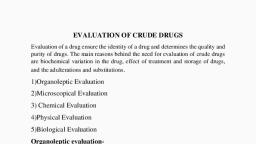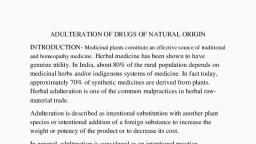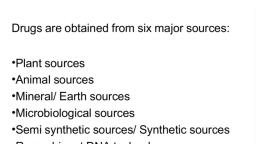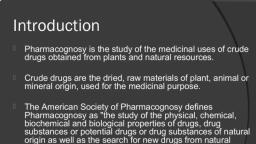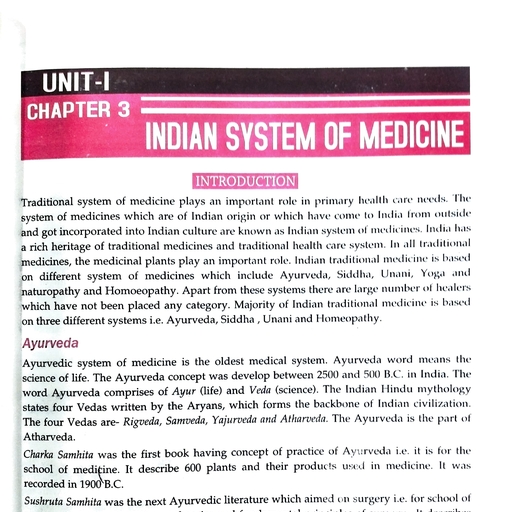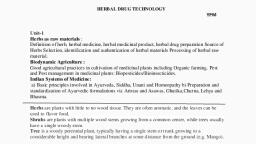Page 2 :
The, , term ’’crude drug’’ generally applies to, the products from plant and animal origin, found in a raw form., The term crude drug also applied, to inclusion of pharmaceutical products from, mineral kingdom., , Crude Drugs, Organized(cellular), , Unorganized(acellular)
Page 3 :
Organised, , drugs consist of the cellular, organization in the form of anatomical, features. These are mostly the crude drugs, from plant sources. Almost all of the, morphological plant parts or the entire plant, itself can be called as an organized drugs ., Eg. Cinchona bark, Sandalwood, Rauwolfia, roots, Nux Vomica seeds, Microscopically and anatomical studies are, preeminent for such drugs. These can be, used directly in medicine or can be used by, modifying or by extracting the active, ingredient from it.
Page 4 :
The, , unorganized drugs do not have the, morphological or anatomical organization as, such. These are the product which come, directly in the market but their ultimate, source remains the plants, animals or, mineral. Microscopical studies are not, required for such crude drugs. These includes, products like plant exudates as gums,, oleogums, oleogumresins, plant lattices like, that of opium, aloetic juices like aloes or, dried extract of black catechu, pale catechu,, agar, alginic acid, etc., are products coming, under this group.
Page 5 :
Drugs, , are classified in the following different, ways-----Alphabetical classification, Taxonomical classification, Morphological classification, , Pharmacological classification, Chemical classification, Chemo taxonomical classification, Serotaxonomical classification
Page 6 :
Simplest way of classification, Crude drugs are arranged according to alphabetical order, of their Latin and English names(common names) or, sometimes local language names(vernacular names)., Some of the Pharmacopoeias, dictionaries and reference, books which classify crude drugs according to this system, are as follows:, IP, BP, British herbal Pharmacopoeia, United states Pharmacopoeia and National Formulary, British Pharmaceutical codex, European Pharmacopoeia, In European Pharmacopoeia these are arranged according to, their names in Latin where in united states pharmacopoeia, and British Pharmaceutical Codex, these are arranged in, English.,
Page 7 :
Merits –, Easy and quick to use, No repetition of entries and is devoid of, confusion, DemeritsNo relationship between previous and, succesive drug entries
Page 8 :
Crude, , drugs are classified according to, kingdom, subkingdom, division, class, order,, family, genus and species as follows., The crude drugs of plant origin are classified, on the basis of one of the accepted systems, of botanical classification. A large number of, plant families have certain distinguishing, characteristics that permit crude drugs from, these families to be studied at one time.
Page 10 :
MeritsTaxonomical classification is helpful for, studying evolutionary developments, DemeritsThis system also does not correlate in, between the chemical constituents and, biological activity of the drugs., Note-this system of classification is criticized, for its failure to recognize the organized and, unorganized nature of the crude drug.
Page 11 :
Crude, , drugs are arranged according to the, morphological or external characters of the, plant parts or animal parts, i.e. which part of, the plant is used as a drug,e.g. leaves, roots,, stem, etc., Seeds- nux-vomica, strophanthus, Isabgol,, castor, Leaves- Senna, Digitalis, Vasaka, Eucalyptus, Barks-cinchona, kurchi,cinnamon, Quaillaia, Woods-Quassia, sandalwood, Sassafras, Red, sanders, Roots-Rauwolfia, Ipecacuanha,Aconite, Jalap
Page 13 :
Merits-, , It is helpful to identify and detect, adulteration., This system of classification is more, convenient for practical study and especially, when the chemical nature of the drug is not, clearly understood., DemeritsThere is no correlation between chemical, constituents and therapeutic actions., Repetition of drugs or plants occurs
Page 14 :
Drugs, are, classified, according, to, their, pharmacological action of their main active, constituent or their therapeutic uses., MeritsThis system of classification can be used for, suggesting substitutes of drugs, if they are not, available at a particular place or point of time., DemeritsDrugs having different action on the body get, classified separately in more than one group that, causes ambiguity and confusion. Cinchona is, antimalarial drug because of presence of quinine, but can be put under the group of drug affecting, heart, because of antiarrhythmic action of, quinidine.,
Page 20 :
Crude, , drugs are classified according to their, chemical constituent. The plants contain, various constituents in them like alkaloid,, glycosides, tannins, carbohydrates, saponin, etc., MeritsIt is popular approach for phytochemical, studies, DemeritsAmbiguities arise when particular drugs possess, a number of compounds belonging to, different groups of compounds.
Page 22 :
This system of classification relies on the, chemical similarity of a taxon, i.e. it is based, on the existence of relationship between, constituents in various plants. There are, certain types of chemical constituents that, characterize certain classes of plants. For, example, tropane alkaloids generally occur, among the members of solanaceae, thereby,, serving as a chemotaxonomic marker., It is the latest system of classification that, gives more scope for understanding the, relationship between chemical constituents,, their biosynthesis and their possile action.
Page 23 :
, , , , , , The serotxonomy can be explained as the study about, the application or the utility of serology in solving the, taxonomical problems. Antibodies are highly specific, protein molecule produced by plasma cells in the, immune system. Protein are carriers of the, taxonomical information and commonly used as, antigen in serotaxonomy., It express the similarities and the dissimilarities, among different taxa, and these data are helpful in, taxonomy. It determines the degree of similarity, between species, genera, family,etc.,by comparing, the reaction with antigens from various plant taxa, with antibodies present against a given taxon., Serology helps in comparing nonmorphological, characterisics, which helps in the taxonomical data., This technique also helps in the comparision of single, proteins from different plant taxa.











